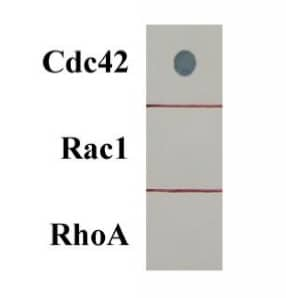Cdc42 Activation Assay Kit (ab211163)
Key features and details
- Sample type: Adherent cells, Suspension cells, Tissue
Overview
-
Product name
Cdc42 Activation Assay Kit
See all CDC42 kits -
Sample type
Tissue, Adherent cells, Suspension cells -
Species reactivity
Reacts with: Mouse, Rat, Human -
Product overview
Cdc42 Activation Assay Kit (ab211163) uses PAK1 PBD Agarose beads to selectively isolate and pull-down the active form of Cdc42 from purified samples or endogenous lysates. Subsequently, the precipitated GTP-Cdc42 is detected by western blot analysis using an anti-Cdc42 specific monoclonal antibody, which reacts with the human, mouse and rat protein.
Features: 1) non radioactive assay format; 2) fast results: 1 hour assay plus electrophoresis/blotting time; 3) includes Cdc42 positive control; 4) pink colored agarose beads for easy identification during washing and aspiration steps.
-
Notes
Small GTP-binding proteins (or GTPases) are a family of proteins that serve as molecular regulators in signaling transduction pathways. Cdc42, a 21 kDa protein, belongs to the family of Rho GTPases and regulates a variety of biological response pathways that include cell motility, cell division, gene transcription, and cell transformation. Like other small GTPases, Cdc42 regulates molecular events by cycling between an inactive GDP-bound form and an active GTP-bound form. In its active (GTP-bound) state, Cdc42 binds specifically to the p21-binding domain (PBD) of p21-activated protein kinase (PAK) to control downstream signaling cascades.
Cdc42 is overexpressed in NSCLC (non-small cell lung cancer), colorectal adenocarcinoma, melanoma, breast cancer and testicular cancer.
Abcam has not and does not intend to apply for the REACH Authorisation of customers’ uses of products that contain European Authorisation list (Annex XIV) substances.
It is the responsibility of our customers to check the necessity of application of REACH Authorisation, and any other relevant authorisations, for their intended uses.
Properties
-
Storage instructions
Store at -20°C. Please refer to protocols. -
Components 20 tests ab211177 - PAK1 PBD Agarose Beads 1 x 200µl 100X GTPyS 1 x 20µl 100X GDP 1 x 20µl 5X Assay/Lysis Buffer 4 x 2ml Anti-Cdc42 Mouse monoclonal antibody 1 x 10µl Cdc42 immunoblot Positive Control 1 x 100µl -
Research areas
-
Function
Plasma membrane-associated small GTPase which cycles between an active GTP-bound and an inactive GDP-bound state. In active state binds to a variety of effector proteins to regulate cellular responses. Involved in epithelial cell polarization processes. Causes the formation of thin, actin-rich surface projections called filopodia. -
Sequence similarities
Belongs to the small GTPase superfamily. Rho family. CDC42 subfamily. -
Post-translational
modificationsAMPylation at Tyr-32 and Thr-35 are mediated by bacterial enzymes in case of infection by H.somnus and V.parahaemolyticus, respectively. AMPylation occurs in the effector region and leads to inactivation of the GTPase activity by preventing the interaction with downstream effectors, thereby inhibiting actin assembly in infected cells. It is unclear whether some human enzyme mediates AMPylation; FICD has such ability in vitro but additional experiments remain to be done to confirm results in vivo. -
Cellular localization
Cell membrane. - Information by UniProt
-
Alternative names
- CDC42
- CDC42_HUMAN
- CDC42Hs
see all -
Database links
- Entrez Gene: 998 Human
- Entrez Gene: 12540 Mouse
- Entrez Gene: 64465 Rat
- Omim: 116952 Human
- SwissProt: P60953 Human
- SwissProt: P60766 Mouse
- SwissProt: Q8CFN2 Rat
- Unigene: 467637 Human
see all
Images
-
Cdc42 activation assay. Lane 1: MW Standard. Lane 2: 293 cell lysate loaded with GDP and incubated with PAK1 PBD Agarose beads. Lane 3: 293 cell lysate loaded with GTPγS and incubated with PAK1 PBD Agarose beads.
-
Detection of Cdc42 positive control (recombinant human Cdc42 from E. coli, partially purified) by immunoblot.
-
Dot blot that demonstrates specificity of anti-Cdc42 mouse antibody.








